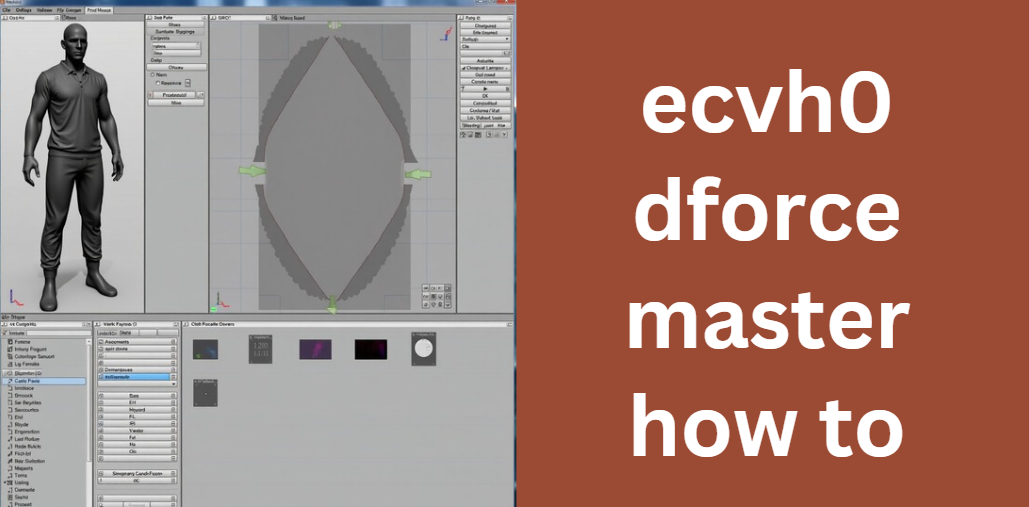Ultimate Guide to ecvh0 dforce master how to: Installation, Usage, Advanced Tips & Troubleshooting
Daz Studio’s dForce engine is known for its ability to simulate realistic fabric behavior such as draping, folding, and collision dynamics. However, mastering its many parameters can be challenging. This is where ecvh0 dforce master how to comes into play.
Designed for both beginners and experienced users, this product simplifies the complex world of cloth simulation by offering a suite of presets. These presets allow you to achieve natural-looking results with just a few clicks, even when working with older clothing assets that were not originally designed for dForce.
By streamlining the process, ecvh0 dforce master how to not only saves you time but also enables you to focus on the creative aspects of your project. Whether you are working on static renders or animations, this guide will walk you through the entire process from installation to advanced customization.
Understanding dForce Simulation in Daz Studio
Daz Studio includes the dForce engine, a physics simulation tool that calculates realistic interactions for soft materials like cloth and hair. At its core, dForce considers forces such as gravity, wind, and collision detection to generate lifelike movement. For example, when a piece of clothing is applied to a character, dForce simulates the fabric’s natural behavior as it interacts with the body and surrounding environment.
The realism achieved through dForce simulation is crucial for high-quality renders. Without it, clothing can appear stiff or unnatural, diminishing the overall visual impact of your scene. Understanding these fundamentals is essential before diving into the specifics of ecvh0 dforce master how to use the presets.
Overview of ecvh0 dforce master how to
ECVH0 dforce master is a specialized tool that provides an extensive collection of cloth simulation presets. Its primary aim is to simplify the process of applying realistic physics to clothing in Daz Studio. This tool is especially beneficial for users who struggle with manually adjusting dForce parameters.
The product offers several key features:
- It includes a variety of presets designed for different garment types, such as shirts, jeans, skirts, and more.
- The presets automatically adjust complex parameters like bending, density, friction, stretch, and velocity.
- It is compatible with both modern and older clothing assets, ensuring that garments not originally designed for dForce can be simulated with natural realism.
The following table summarizes its main features:
| Feature | Description |
|---|---|
| Preset Collection | Offers numerous presets tailored for different types of clothing, streamlining cloth simulation. |
| Automated Parameter Adjustment | Automatically tweaks settings for bending, density, friction, stretch, and velocity. |
| Broad Compatibility | Works with both new garments and older assets from earlier Genesis versions in Daz Studio. |
| User-Friendly Interface | Designed to simplify the complex dForce engine into a few easy-to-apply preset options. |
Installation and Setup
Before you can start using ecvh0 dforce master how to, you must ensure that your system meets the necessary requirements. You need to have a dForce-compatible version of Daz Studio (version 4.10 or later) and a proper setup of your hardware to run simulations effectively.
After confirming the prerequisites, you can install the product using one of several methods. You might choose Daz Connect, the Install Manager, or manual installation according to the provided instructions. Once installed, open Daz Studio and configure your workspace by enabling the dForce simulation panes. These include the Simulation Settings, Surfaces, and Tool Settings. Setting up these panels correctly is crucial for a smooth simulation experience.
Applying ECVH0 dForce Master Presets
Using ecvh0 dforce master how to apply presets is a straightforward process that requires only a few steps. Start by loading your scene and selecting the clothing asset you wish to simulate. Then, from the product’s menu, choose the preset that best fits your garment. For example, if you are working with a shirt, select the corresponding shirt preset.
Once the preset is applied, run the simulation within Daz Studio. Observe how the fabric responds—realistic folds and draping should appear naturally. If necessary, you can perform minor adjustments to fine-tune the simulation. However, the majority of users will find that the preset settings yield excellent results right out of the box.
Here is a simplified list of the process:
- Open your project in Daz Studio.
- Select the clothing item and access the ECVH0 preset menu.
- Choose the appropriate preset and apply it.
- Run the simulation and review the cloth behavior.
- Make any minor adjustments if needed.
Advanced Techniques
For those looking to take their simulations to the next level, advanced techniques can enhance the effectiveness of ecvh0 dforce master how to use the presets. One such technique involves combining the presets with custom weight mapping. Weight mapping allows you to define which parts of the garment should be more dynamic and which should remain relatively static. This is especially useful for complex poses or when working with garments that interact closely with the character’s body.
Another advanced approach is optimizing simulations for animated sequences. By setting up simulations across multiple frames and adjusting timeline settings, you can ensure that the cloth behaves consistently throughout an animation. Troubleshooting common issues such as mesh explosions or unrealistic folds is also covered in this section, along with practical solutions to overcome these challenges.
Best Practices and Tips
Integrating ecvh0 dforce master how to into your workflow involves several best practices. It is important to always verify the compatibility of your clothing assets with dForce, especially if you are using older models. Consistency is key; saving and reusing presets across similar projects can help maintain a uniform look and save valuable time.
Additionally, consider the following performance enhancements: optimize simulation settings to reduce render times without compromising on quality, and experiment with minor tweaks rather than starting from scratch each time. Such practices ensure that your simulations are both efficient and visually appealing.
Frequently Asked Questions
How can I optimize my system’s hardware to run dForce simulations smoothly with ecvh0 dforce master?
For the best performance, ensure your system has a dedicated graphics card (preferably NVIDIA or AMD with the latest drivers), a multi-core processor, and at least 16 GB of RAM. A fast SSD and a well-ventilated system can also help reduce simulation times and prevent overheating during intensive simulations.
What is the recommended process for updating or upgrading ecvh0 dforce master presets?
Updates are typically released through the official Daz 3D marketplace or the product’s dedicated website. It is advisable to subscribe to the developer’s newsletter or join user forums to receive notifications about new versions, bug fixes, or enhanced preset features. Always back up your current presets before installing updates.
Are there dedicated online communities or forums where I can discuss ecvh0 dforce master experiences?
Yes, several Daz Studio forums and user groups focus on cloth simulation and dForce techniques. Platforms like the official Daz3D Forums, RenderGuide Community, and specialized Facebook groups can be excellent resources for sharing tips, troubleshooting issues, and discovering creative uses of ecvh0 dforce master how to.
Which clothing asset file formats and types are compatible with ecvh0 dforce master?
ECVH0 dforce master is designed to work seamlessly with Daz Studio assets, including those from older Genesis generations and modern clothing items. The presets support commonly used file formats such as .duf (Daz User File) and are compatible with garments that have been prepared for dForce simulation, even if they were not originally created for it.
Can ecvh0 dforce master presets be integrated with other simulation tools or plugins in Daz Studio?
Yes, the presets are designed to be flexible and can often be used alongside other plugins or custom weight mapping tools. However, it is important to test compatibility in a controlled scene to ensure that overlapping simulation parameters do not conflict, which might require minor adjustments for seamless integration.
Conclusion
In conclusion, this guide on ecvh0 dforce master how to provides an exhaustive overview of how to harness the power of dForce presets in Daz Studio. From installation and basic usage to advanced customization and troubleshooting, every aspect has been covered in clear, easy-to-understand language.
By incorporating best practices and leveraging additional resources, you can achieve realistic cloth simulations that enhance your 3D renders and animations. We hope this guide empowers you to experiment confidently and integrate these techniques into your creative workflow. Happy simulating!
Read more
In-Depth Guide on the 1992 corvette have shaft u joint spicer 3615x
The Ultimate Guide to class for aspiring u.s. citizens abbr
The Ultimate Guide to achilies heel swade spc
Comprehensive Guide to fix on six mini implants erie pa
Comprehensive Guide to plugboxlinux fashion and interior design






